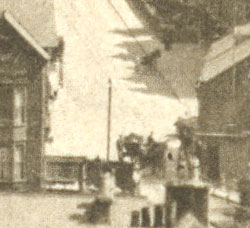| Matlock
Bank, Summer 1904 (2) |
| Matlock : Twentieth Century Photographs, Postcards,
Engravings & Etchings |
| |
|
|
Tuck's postcard of Matlock Bridge and Bank was taken at a very similar
time to the previous image as
the development on the Bank is at exactly the same stage. The
picture was taken at the time when the County Bridge was being
widened and we can see just a couple of minor things relating
to the widening in the enlargement below. A fence, which sticks
out from the Crown Square shops on the left, has been put up
to partially block the roadway across the bridge. It is impossible
to tell whether the vehicles are horses with carts or horses
with carriages but they seem to be waiting outside Orme's grocery
store on the right to cross the bridge. Look carefully and you
can also just see the beginning of the temporary footbridge that
had been erected.

The County Bridge was partially closed. |
Local carters were encountering difficulties when descending the
Matlock hills and some attached slippers, a kind of skid or shoe
with studs in them, to the wheels of their drugs as a means of
retarding the speed of their vehicles when going downhill. Slippers
would have been especially useful when the drugs were carrying
a heavy load, such as stone. The road surfaces, made from successive
layers of crushed limestone which was covered in mud and then
rolled (macadam), were not good[1].
The iron tyres on both carts and carriages caused deep ruts.
Heavily loaded drugs, especially with slippers or skids on them,
were breaking up the road surfaces and making things worse.
One problem aggravated the other. In early
November 1904 the Council's Surveyor, Mr. James Diggle, alerted
the Council to the damage being caused to Matlock's roads by
the slippers[2].
They then needed to make an example of someone for causing
damage. On the 30th November a man named Thomas Wood of Darley
Dale was summoned for using a slipper with studs on 2 November,
having carted four tons of stone from Rockside Terrace down Wellington
Street. The Surveyor estimated the damage that Wood had caused
was 5 shillings[3].
The following summer a dray became unmanageable, colliding
with a lamp post near the town hall and then skidding across
the road. The driver, Frank Booth, sustained a fractured jaw
and other injuries[4].
|
"Matlock Bridge & Bank". Raphael Tuck & Sons O'er
Hill and Dale Post Card, No.2250 Matlock Bath and Matlock Bridge.
Posted on 21 Sep 1907 at Derby. An unposted version has the words
Photo Holland in the stamp box.
Postcard in the collection of and provided by and © Ann Andrews.
Researched, written by and © Ann Andrews.
Intended for personal use only.
|
References (coloured
links are to transcripts or more information elsewhere on this
web site):
[1] Macadam for road surfaces was made
up of materials advocated by J. L. McAdam many years before.
Each layer of stone was rolled before the next one was laid.
Tarmac, or tarmacadam, was introduced later on.
[2] "Derbyshire Times",
9 November 1904. Other and Varied Subjects (discussed by yhr Council).
[3] "Derbyshire Times",
3 December 1904.
[4] "Derbyshire Courier",
26 August 1905. Dray Accident at Matlock.
|
|




